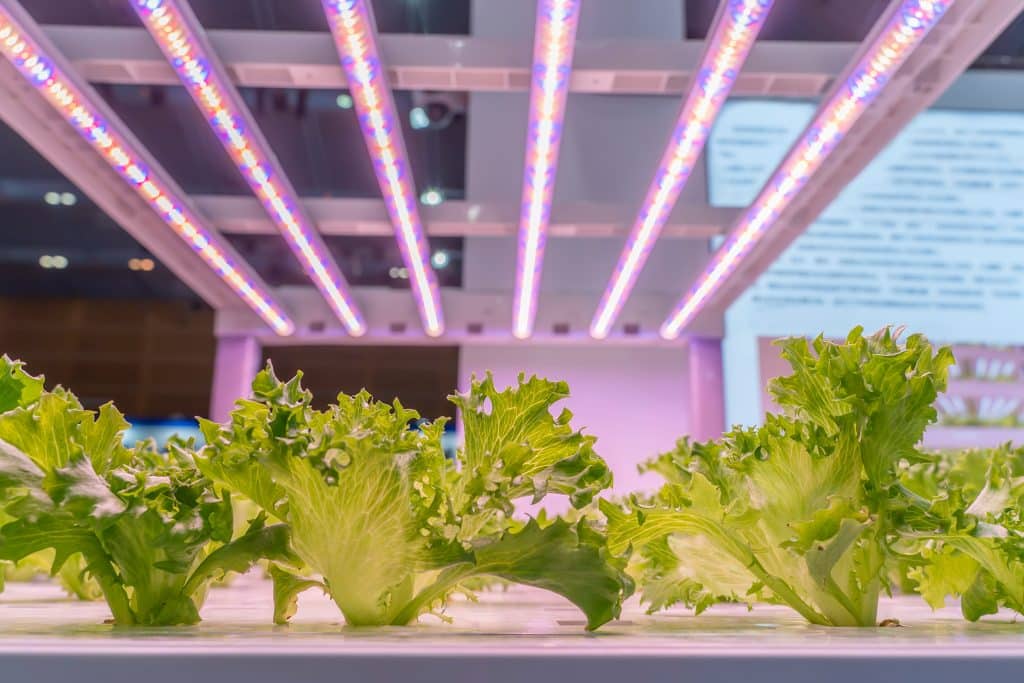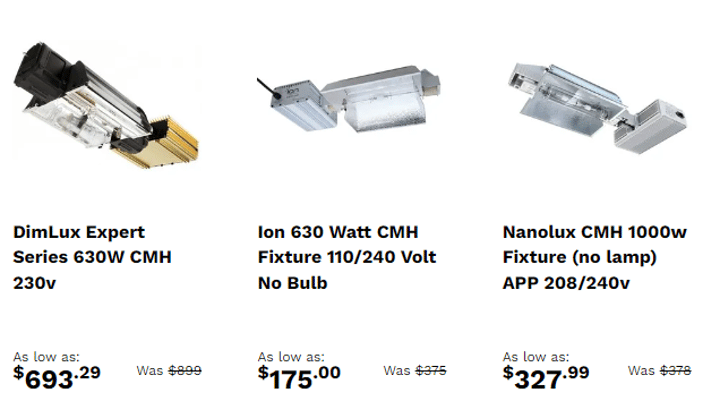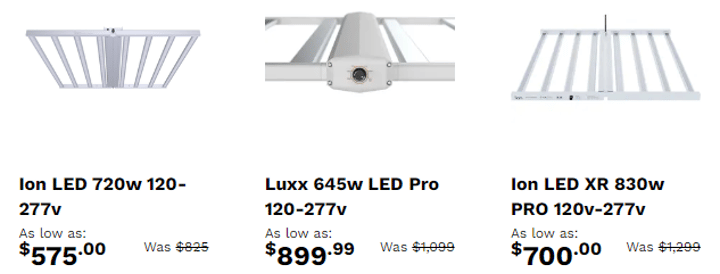“Should we use CMH or LED grow lights?” It’s a question many growers ask. But, the answer depends on your system’s needs. Here is an informative comparison guide between CMH vs LED grow lights to help you decide which type will work best for your grow.
CMH vs LED Grow Lights: What’s the Difference?
When considering LED vs CMH grow lights, it’s important to understand the differences between these lighting systems so that you can make an informed decision based on your needs! Let’s start with a basic overview of each grow light technology and look at what each one offers growers.
CMH Grow Lights
Ceramic metal halide (CMH) grow lights use an arc tube filled with a mix of metal halides and rare noble gases. When a large amount of electricity is introduced, the electricity completes a circuit across the arc tube and excites the gas. This ignition causes extremely high temperatures, which mixes the gas and metal halide elements into a plasma state – giving off heat and lots of light.
The benefits of using CMH grow lights include the following:
- Provides a full spectrum of light, including UV and infrared — ideal for plants that need a complete light spectrum for optimal growth
- Produces more light per watt than other similar High Intensity Discharge (HID) lighting systems
The downside of CMH lights (like other High Intensity Discharge lights) is that they produce a lot of heat, requiring extra ventilation to prevent your grow room from overheating. They also tend to be more expensive than other HID lights, though cheaper than LED grow lights.
LED Grow Lights
How do LED lights help plants grow? Light-emitting diode (LED) grow lights use semiconductor chips to produce light. Electrons are in a process called “recombination”. Electrons are forced or injected into a semiconductor material, and in the process of accumulation and the release, the electrons emit light.
The benefits of using LED grow lights for indoor plants include the following:
- Most energy-efficient grow lighting systems available – can lower production costs
- Emits little heat—use less air conditioning to keep your grow room at the right temperature
- Additional ventilation is not required
- Longer lifespan (LED bulbs: 50,000 hours; CMH bulbs: 20,000 hours)
- Durable systems
The downside of LED grow lights is that they tend to be more expensive upfront than other grow lights. Infra-red and UV diodes can be very expensive.

CMH vs. LED: 8 Things to Consider
Both CMH and LED have advantages and disadvantages, so it is important to understand their differences before investing in a grow lighting system. Let’s look at a few of the deciding factors a little more closely.
1. CMH vs LED Light Spectrum
The spectrum of light that each technology can provide is one of the most important factors when choosing grow lights for plants. The light spectrum is the range of colors that light produces. Plants need different colors of light for different stages of growth. For example, blue light is necessary for vegetative growth, while red light is essential for flowering and fruiting.
| CMH Light Spectrum | LED Light Spectrum |
| Provide full spectrum of light including UV and infrared Ideal for plants that need a complete light spectrum for optimal growth All light colors available | Most provide a partial spectrum of light due to their brightness and energy-efficiency Requires a lamp with a high PAR value to ensure plants get enough light spectrum Customizable colors available |
Most LED lighting systems do not produce a full spectrum of light, but you can customize the mix of colors to match the specific needs of your plants. For example, you can get LED grow lights with more blue light if you are growing plants that require more vegetative growth. You can also find specialty full spectrum LED grow lights with enhanced blue and red for all-around multipurpose use at many retailers, and in some cases you may find fixtures with tune-able spectrum that one can change.
In contrast, CMH grow lights offer full spectrum lighting, including UV and infrared. CMH lighting can provide the right color spectrum required for every plant growth stage.
2. CMH vs LED Heat Emission
Another critical factor to consider when choosing grow lights is heat emission. Grow lights produce heat as a byproduct of light production. If the heat produced by a grow light is not circulated correctly through a ventilation system, it can damage your crops through heat stress, plant burn, or death.
| CMH Heat Emission | LED Heat Emission |
| Produces high heat levels Requires extra ventilation to prevent heat stress or plant burn Further distance from plants | Produces low heat levels No extra ventilation equipment required compared to the standard HID systems Closer plant proximity |
Grow lights must be at the correct temperature to give your plants the right amount of heat. Since CMH grow lights radiate more heat, cooling equipment such as fans or air conditioners is required to prevent overheating the grow room. It is important to note that grow lighting systems that emit more heat typically should be placed further away from plants to avoid damage.
In contrast, LED grow lights do not radiate much heat, so less cooling equipment is typically needed to balance the temperature it emits. This allows for closer plant proximity without risking damage.
3. CMH vs LED Height Restrictions
LED and CMH lighting have different recommendations for how high they should be from plants. Hotter CMH lighting needs to be at least 36 inches from the plant canopy, while cooler LED lighting is recommended to be 18-24 inches above the plant canopy.
This means that growers with grow room setups that include less space above plants (less than 8 ft ceiling height) would need to look into LED lighting.
4. CMH vs LED Canopy Penetration
Canopy penetration is a grow light’s ability to reach the lower parts of a plant. Plants need light at all levels to grow correctly. If a grow light does not penetrate the canopy, the lower plant parts will not receive enough light and cannot photosynthesize properly.
| CMH Light Canopy Penetration | LED Light Canopy Penetration |
| Deep and intense canopy penetration More intense than LED Reaches lower plant parts | Good canopy penetration Less intense than CMH Can still reach the lower plant parts |
Canopy penetration helps determine the kind of light you need. If you are growing tall plants with a lot of foliage, you will need a grow light that penetrates the canopy well and can reach the plant’s bottom leaves.
Generally, CMH will have higher penetration because of its higher-rated wattage/power. However, LED grow lights can be placed between canopies and installed both horizontally and vertically to allow growers to reach any part of the canopy. Also, some LED fixtures incorporate optics on their diodes that can greatly enhance their penetrating capabilities.
5. CMH vs LED Growing Area Size
The size of the growing area is an essential factor to consider when choosing grow lights. The larger the growing area, the more light is needed to provide adequate coverage.
| CMH Light Coverage | LED Light Coverage |
| Ideal for large-scale hydroponics systems & cultivation facilities Wider light coverage areas One CMH bulb can provide enough light for a 4×4 grow space | Ideal for small to medium hydroponics systems or vertical farming Smaller light coverage areas One LED fixture can provide enough light for a small 2×2 grow room or more depending on the fixture’s wattage |
Depending on the power factor of your choice of LED grow lights, you may need multiple LED fixtures to provide adequate coverage.
6. CMH vs LED Cultivation Goals
Your plant cultivation goals will also influence the type of grow light you choose. If you are growing plants for their foliage, you will need a grow light that produces blue light. CMH grow lights are a good choice for foliage growers because they make a full spectrum of light, including lots of blue light.
If you are growing plants for their flowers or fruits, you will need a grow light that produces red light. LED grow lights are a good choice for flowering and fruiting plants because you can customize them to create lots of red light.
| CMH Lighting Goals | LED Lighting Goals |
| Best applied for foliage Full spectrum and blue lighting available | Best applied for flowers and fruits Customizable red lights available |
So, which type of grow light is best for your hydroponics system? The answer depends on your specific needs and budget. LED grow lights for indoor plants are ideal if you are looking for energy-efficient lighting that does not produce much heat.
7. CMH vs LED Initial Investment
Generally, LED grow lights cost 2-4 times more than CMH to get your setup going. Our LED grow lights range from $100 to $3,000+ (depending on the wattage), while CMH grow lights range from $200 to $500+.
LED’s cost more upfront but cost less to operate and last longer. So, the decision really depends on how long you plan to reach your maximum ROI for your grow room equipment.
8. CMH vs LED Replacement Bulbs
You will need to replace CMH bulbs about every 12 months, but not LEDs. They are supposed to last eight to nine years before their usable life is over.
Choosing Between CMH and LED Lights
Now that you understand the differences between CMH vs. LED plant grow lights, it is time to start shopping. While both are excellent options for indoor growing, the best lighting type for your plants depends on your growing area, the plants growing, and your gardening goals.
Consider CMH Grow Lights If…
- You need to maximize your gram per watt production
- You don’t have a long-term plan (LEDs have a better long-term ROI, but cost more up-front)
- You need beneficial UV spectrum light
- You are growing strains that require greater canopy penetration
GrowGeneration CMH Grow Lights

Consider LED Grow Lights If…
- You are growing a strain that needs to be tuned to a specific wavelength
- You have a long-term plan for your grow room (to give enough time for LEDs to be worth it)
- You have less space above your plants
Compare LED Grow Lights

Have Grow Light Questions?
If you are unsure which lighting choice is right for you, our team of experts can help find the perfect grow lights for your setup. Talk to a GrowPro for any questions about grow light options today or find our find a local GrowGeneration store.







